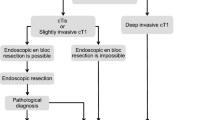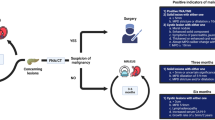Abstract
Background
Missed and incompletely resected lesions remain the main cause of the recurrence of advanced neoplasms (ANs) in post-polypectomy patients. This study aims to determine whether the recurrence of ANs can be predicted and reduced by the newly developed clear colonoscopy procedure.
Methods
Between 2006 and 2010, a total of 1350 participants with colorectal neoplasm were equally randomized to clear colonoscopy surveillance (CCS) and routine colonoscopy surveillance (RCS) in our center. Clear colonoscopy was achieved through repeat colonoscopy. On surveillance colonoscopy at 3 (for high-risk patients) and 5 (for low-risk patients) years, the recurrence of ANs and the relationship between the frequency of repeat examinations required for a clear colonoscopy and the recurrence of ANs were analyzed.
Results
Surveillance colonoscopy at 3 and 5 years showed that the incidence of ANs in patients belonging to the CCS group was 1.7%, which was lower than 4.7% in patients belonging to the RCS group (P = 0.012) for both high- and low-risk patients. Out of the 1126 patients who achieved clear colonoscopy on first repeat examination, only 5 ( 0.4%) were found to have ANs on surveillance examination, whereas 12 out of the 217 (5.4%) patients on second repeat examination and 5 out of the 29 (17.2%) patients on third repeat examination were found to have ANs (P < 0.001).
Conclusion
Surveillance based on clear colonoscopy decreased the incidence of ANs in post-polypectomy patients. The number of repeat examinations required for a clear colonoscopy is an important factor in the prediction of the recurrence of ANs.


Similar content being viewed by others
References
GBD (2013) Mortality and Causes of Death Collaborators (2015) Global, regional, and national age-sex specific all-cause and cause-specific mortality for 240 causes of death, 1990–2013: a systematic analysis for the Global Burden of Disease Study 2013. Lancet 385(9963):117–171. https://doi.org/10.1016/S0140-6736(14)61682-2]
Zauber AG, Winawer SJ, O’Brien MJ, Lansdorp-Vogelaar I, van Ballegooijen M, Hankey BF, Shi W, Bond JH, Schapiro M, Panish JF, Stewart ET, Waye JD (2012) Colonoscopic polypectomy and long-term prevention of colorectal-cancer deaths. N Engl J Med 366(8):687–696. https://doi.org/10.1056/NEJMoa1100370
Hassan C, Quintero E, Dumonceau JM, Regula J, Brandão C, Chaussade S, Dekker E, Dinis-Ribeiro M, Ferlitsch M, Gimeno-García A, Hazewinkel Y, Jover R, Kalager M, Loberg M, Pox C, Rembacken B, Lieberman D (2013) Post-polypectomy colonoscopy surveillance: European Society of Gastrointestinal Endoscopy (ESGE) Guidelines. Endoscopy 45(10):842–851. https://doi.org/10.1055/s-0033-1344548
Sanduleanu S, le Clercq CM, Dekker E, Rabeneck L, Rutter MD, Valori R, Young GP, Schoen RE (2015) Definition and taxonomy of interval colorectal cancers: a proposal for standardizing nomenclature. Gut 64(8):1257–1267. https://doi.org/10.1136/gutjnl-2014-307992
Cooper GS, Xu F, Barnholtz Sloan JS, Schluchter MD, Koroukian SM (2012) Prevalence and predictors of interval colorectal cancers in medic are beneficiaries. Cancer 118(11):3044–3052. https://doi.org/10.1002/cncr.26602
Samadder NJ, Curtin K, Tuohy TM, Provenzale D, Rowe KG, Mineau GP, Smith K, Pimentel R, Kirchhoff AC, Burt RW (2014) Characteristics of missed or interval colorectal cancer and patient survival: a population-based study. Gastroenterology 146(4):950–960. https://doi.org/10.1053/j.gastro.2014.01.013
Le Clercq CM, Bouwens MW, Rondagh EJ, Bakker CM, Keulen ET, de Ridder RJ, Winkens B, Masclee AA, Sanduleanu S (2014) Postcolonoscopy colorectal cancers are preventable: a population-based study. Gut 63(6):957–963. https://doi.org/10.1136/gutjnl-2013-304880
Brenner H, Chang-Claude J, Seiler CM, Hoffmeister M (2012) Interval cancers after negative colonoscopy: population-based case control study. Gut 61(11):1576–1582. https://doi.org/10.1136/gutjnl-2011-301531
Robertson DJ, Lieberman DA, Winawer SJ, Ahnen DJ, Baron JA, Schatzkin A, Cross AJ, Zauber AG, Church TR, Lance P, Greenberg ER, Martínez ME (2014) Colorectal cancers soon after colonoscopy: a pooled multi cohort analysis. Gut 63(6):949–956. https://doi.org/10.1136/gutjnl-2012-303796
Higurashi T, Hosono K, Takahashi H, Komiya Y, Umezawa S, Sakai E, Uchiyama T, Taniguchi L, Hata Y, Uchiyama S, Hattori A, Nagase H, Kessoku T, Arimoto J, Matsuhashi N, Inayama Y, Yamanaka S, Taguri M, Nakajima A (2016) Metformin for chemoprevention of metachronous colorectal adenoma or polyps in post-polypectomy patients without diabetes: a multicentre double-blind, placebo-controlled, randomised phase 3 trial. Lancet Oncol 17(4):475–483. https://doi.org/10.1016/S1470-2045(15)00565-3
Gao QY, Chen HM, Sheng JQ, Zheng P, Yu CG, Jiang B, Fang JY (2010) The first year follow-up after colorectal adenoma polypectomy is important: 528 a multiple-center study in symptomatic hospital-based individuals in China. Front Med China 4(4):436–442. https://doi.org/10.1007/s11684-010-0200-9
Fang JY, Zheng S, Jiang B, Lai MD, Fang DC, Han Y, Sheng QJ, Li JN, Chen YX, Gao QY (2014) Consensus on the prevention, screening, early diagnosis and treatment of colorectal tumors in China: Chinese Society of Gastroenterology, October 14–15, 2011, Shanghai, China. Gastrointest Tumors 1(2):53–75. https://doi.org/10.1159/000362585
Corley DA, Jensen CD, Marks AR, Zhao WK, Lee JK, Doubeni CA, Zauber AG, de Boer J, Fireman BH, Schottinger JE, Quinn VP, Ghai NR, Levin TR, Quesenberry CP (2014) Adenoma detection rate and risk of colorectal cancer and death. N Engl J Med 370(14):1298–1306. https://doi.org/10.1056/NEJMoa1309086
Adler J, Robertson DJ (2015) Interval colorectal cancer after colonoscopy: exploring explanations and solutions. Am J Gastroenterol 110(12):1657–1664. https://doi.org/10.1038/ajg.2015.365
Lieberman DA, Rex DK, Winawer SJ, Giardiello FM, Johnson DA, Levin TR (2012) Guidelines for colonoscopy surveillance after screening and polypectomy: a consensus update by the US Multi-Society Task Force on Colorectal Cancer. Gastroenterology 143(3):844–857. https://doi.org/10.1053/j.gastro.2012.06.001
Rex DK, Ahnen DJ, Baron JA, Batts KP, Burke CA, Burt RW, Goldblum JR, Guillem JG, Kahi CJ, Kalady MF, O'Brien MJ, Odze RD, Ogino S, Parry S, Snover DC, Torlakovic EE, Wise PE, Young J, Church J (2012) Serrated lesions of the colorectum: review and recommendations from an expert panel. Am J Gastroenterol 107(9):1315–1329. https://doi.org/10.1038/ajg.2012.161
Cottet V, Jooste V, Fournel I, Bouvier AM, Faivre J, Bonithon-Kopp C (2012) Long-term risk of colorectal cancer aft er adenoma removal: a population-based cohort study. Gut 61(8):1180–1186. https://doi.org/10.1136/gutjnl-2011-300295
Chung SJ, Kim YS, Yang SY, Song JH, Kim D, Park MJ, Kim SG, Song IS, Kim JS (2011) Five-year risk for advanced colorectal neoplasia aft er initial colonoscopy according to the baseline risk stratification: a prospective study in 2452 asymptomatic Koreans. Gut 60(11):1537–1543. https://doi.org/10.1136/gut.2010.232876
Lai EJ, Calderwood AH, Doros G, Fix OK, Jacobson BC (2009) The Boston bowel preparation scale: a valid and reliable instrument for colonoscopy oriented research. Gastrointest Endosc 69(3 Pt 2):620–625. https://doi.org/10.1016/j.gie.2008.05.057
Lieberman DA, Weiss DG, Harford WV, Ahnen DJ, Provenzale D, Sontag SJ, Schnell TG, Chejfec G, Campbell DR, Kidao J, Bond JH, Nelson DB, Triadafilopoulos G, Ramirez FC, Collins JF, Johnston TK, McQuaid KR, Garewal H, Sampliner RE, Esquivel R, Robertson D (2007) Five-year colon surveillance after screening colonoscopy. Gastroenterology 133(4):1077–1085. https://doi.org/10.1053/j.gastro.2007.07.006
Brenner H, Haug U, Hoffmeister M (2008) Five-year risk of colorectalneoplasia after negative screening colonoscopy. N Engl J Med 359(24):2611
Singh H, Turner D, Xue L, Targownik LE, Bernstein CN (2006) Risk of developing colorectal cancer following a negative colonoscopy examination. Evidence for a 10-year interval between colonoscopies. JAMA 295(20):2366–2373. https://doi.org/10.1001/jama.295.20.2366
Brenner H, Haug U, Arndt V, Stegmaier C, Altenhofen L, Hoffmeister M (2010) Low risk of colorectal cancer and advanced adenomas more than 10 years after negative colonoscopy. Gastroenterology 138(3):870–876. https://doi.org/10.1053/j.gastro.2009.10.054
Robertson DJ, Burke CA, Welch HG, Haile RW, Sandler RS, Greenberg ER, Ahnen DJ, Bresalier RS, Rothstein RI, Cole B, Mott LA, Baron JA (2009) Using the results of a baseline and a surveillance colonoscopy to predict recurrent adenomas with high-risk characteristics. Ann Intern Med 151(2):103–109
Laiyemo AO, Pinsky PF, Marcus PM, Lanza E, Cross AJ, Schatzkin A (2009) Utilization and yield of surveillance colonoscopy in the continued follow-up study of the polyp prevention trial. Clin Gastroenterol Hepatol 7(5):562–567. https://doi.org/10.1016/j.cgh.2008.12.009
Blumberg D, Opelka FG, Hicks TC, Timmcke AE, Beck DE (2000) Significance of a normal surveillance colonoscopy in patients with a history of adenomatous polyps. Dis Colon Rectum 43(8):1084–1091
Lieberman D, Ladabaum U, Cruz-Correa M, Ginsburg C, Inadomi JM, Kim LS, Giardiello FM, Wender RC (2016) Screening for colorectal cancer and evolving issues for physicians and patients: a review. JAMA 316(20):2135–2145. https://doi.org/10.1001/jama.2016.17418
Erichsen R, Baron JA, Hamilton-Dutoit SJ, Snover DC, Torlakovic EE, Pedersen FT, Vyberg M, Hamilton SR, Sørensen HT (2016) Increased risk of colorectal cancer development among patients with serrated polyps. Gastroenterology 150(4):895–902. https://doi.org/10.1053/j.gastro.2015.11.046
IJspeert JE, de Wit K, van der Vlugt M, Bastiaansen BA, Fockens P, Dekker E (2016) Distribution and risk of sessile serrated adenomas/polyps at a center with a high adenoma detection rate and experienced pathologists. Endoscopy 48(8):740–746. https://doi.org/10.1055/s-0042-105436
Acknowledgements
We thank LetPub (www.letpub.com) for its linguistic assistance during the preparation of this manuscript.
Author information
Authors and Affiliations
Corresponding author
Ethics declarations
Disclosure
Drs. Qisheng Zhang, Yucui Shen, Jianhua Xu, Bing Han, and Peng Gao have no conflicts of interest or financial ties to disclose.
Additional information
Publisher's Note
Springer Nature remains neutral with regard to jurisdictional claims in published maps and institutional affiliations.
Qisheng Zhang and Yucui Shen have contributed equally to this work.
Electronic supplementary material
Below is the link to the electronic supplementary material.
Rights and permissions
About this article
Cite this article
Zhang, Q., Shen, Y., Xu, J. et al. Clear colonoscopy as a surveillance tool in the prediction and reduction of advanced neoplasms: a randomized controlled trial. Surg Endosc 35, 4501–4510 (2021). https://doi.org/10.1007/s00464-020-07964-z
Received:
Accepted:
Published:
Issue Date:
DOI: https://doi.org/10.1007/s00464-020-07964-z




